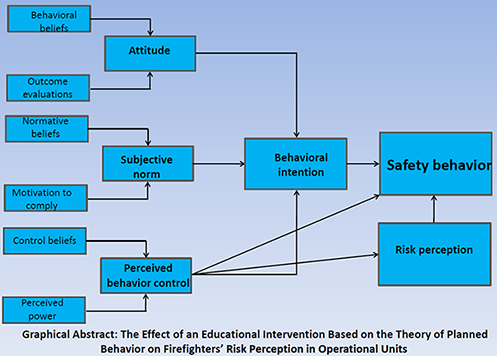Volume 11, Issue 2 (6-2021)
J Health Saf Work 2021, 11(2): 237-251 |
Back to browse issues page
Download citation:
BibTeX | RIS | EndNote | Medlars | ProCite | Reference Manager | RefWorks
Send citation to:



BibTeX | RIS | EndNote | Medlars | ProCite | Reference Manager | RefWorks
Send citation to:
Omidi S, Jennat Feridooni G, Farmanbar R, Heidari M. The Effect of an Educational Intervention Based on the Theory of Planned Behavior on Firefighters’ Risk Perception in Operational Units. J Health Saf Work 2021; 11 (2) :237-251
URL: http://jhsw.tums.ac.ir/article-1-6500-en.html
URL: http://jhsw.tums.ac.ir/article-1-6500-en.html
1- Department of Health Education and Health Promotion, School of Health, Guilan University of Medical Sciences, Rasht, Iran
2- Department of Occupational Health, School of Health, Guilan University of Medical Sciences, Rasht, Iran / Research Center of Health and Environment, Guilan University of Medical Sciences, Rasht, Iran ,heidari@gums.ac.ir
2- Department of Occupational Health, School of Health, Guilan University of Medical Sciences, Rasht, Iran / Research Center of Health and Environment, Guilan University of Medical Sciences, Rasht, Iran ,
Abstract: (2419 Views)
Introduction: Risk perception to safety and health is particularly important and affects behavior. Most of accidents occur because people do not have proper understanding about them. Accidents may be an important consequence of risk perception or, more precisely, an inaccurate perception of risk. Education has been always widely recognized as an important component of occupational risk management programs. The aim of this study was investigating the effect of an educational intervention based on the theory of planned behavior on firefighters’ risk perception in operational units.
Material and Methods: This study was a randomized controlled trial performed on 92 firefighters, in Rasht, in 2019. Cluster sampling method was carried out, and the firefighters were randomly assigned to two experimental and control groups with equal numbers. Data collection instrument was a questionnaire with the three sections including demographic variables, risk perception, theory of planned behavior constructs. The educational program consisted of five sessions of 30-75 minutes for each group (six groups of 7-8 firefighters). The data were collected before and one month after educational intervention, and analyzed by Chi-square, independent and paired-sample T test, Mann-Whitney U and Wilcoxon using SPSS software version 21.
Results: The mean age of firefighters was 35.91±5.17 years, and no significant difference was observed between the two groups in demographic variables. Before the educational intervention, no significant difference was seen between the intervention and control groups in risk perception, the model constructs and self-report behaviors, but after performing the educational intervention the variables were significantly increased in the intervention group.
Conclusion: The current study results showed an improvement in firefighters’ risk perception due to educational intervention based on the theory of planned behavior. Thus, the theory of planned behavior can be used as a theoretical framework for the design and implementation of firefighters’ risk perception.
Material and Methods: This study was a randomized controlled trial performed on 92 firefighters, in Rasht, in 2019. Cluster sampling method was carried out, and the firefighters were randomly assigned to two experimental and control groups with equal numbers. Data collection instrument was a questionnaire with the three sections including demographic variables, risk perception, theory of planned behavior constructs. The educational program consisted of five sessions of 30-75 minutes for each group (six groups of 7-8 firefighters). The data were collected before and one month after educational intervention, and analyzed by Chi-square, independent and paired-sample T test, Mann-Whitney U and Wilcoxon using SPSS software version 21.
Results: The mean age of firefighters was 35.91±5.17 years, and no significant difference was observed between the two groups in demographic variables. Before the educational intervention, no significant difference was seen between the intervention and control groups in risk perception, the model constructs and self-report behaviors, but after performing the educational intervention the variables were significantly increased in the intervention group.
Conclusion: The current study results showed an improvement in firefighters’ risk perception due to educational intervention based on the theory of planned behavior. Thus, the theory of planned behavior can be used as a theoretical framework for the design and implementation of firefighters’ risk perception.
Type of Study: Research |
Received: 2021/06/12 | Accepted: 2021/06/12 | Published: 2021/06/12
Received: 2021/06/12 | Accepted: 2021/06/12 | Published: 2021/06/12
Send email to the article author
| Rights and permissions | |
 |
This work is licensed under a Creative Commons Attribution-NonCommercial 4.0 International License. |






